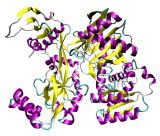
15/10/2014
The new voyage of the 'Argonautes'
Researchers of the Computational Genomics group of GRIB (IMIM-UPF) led by Eduardo Eyras, CRG, University of Buenos Aires and the Max Planck Institute in Gottingen have recently published a study in PNAS, reporting that Argonaute proteins play an important role in the regulation of genes in the cell nucleus. The published work describes how Argonaute proteins, besides their role in post-transcriptional regulation, can also affect gene expression during transcription, the cell process that makes mRNA from DNA.
Small RNA molecules, which include the so called micro-RNAs (miRNAs), provide a powerful mechanism to regulate gene expression in the cell cytoplasm either by triggering degradation of the messenger RNAs molecules (mRNA) or by inhibiting their translation into proteins. This mechanism, known as post-transcriptional gene silencing, takes place in the cell cytoplasm and has important implications for understanding developmental and disease processes. The miRNAs are guided to their targets by a molecular complex that is made of a group of proteins called Argonautes. These proteins are essential to direct the miRNAs to their mRNA targets, and their structure and role in the post-transcriptional gene silencing has been thoroughly described up to date.
Argonaute can bind to transcriptional enhancers hat control of the expression of genes
In particular, this work shows evidence that Argonaute can bind to specific locations of the genome. These locations are transcriptional enhancers, regions in the DNA that control of the expression of one or multiple genes by governing when these genes must be turned on or off.
Enhancers are usually placed far from the genes they regulate, but they can also occur inside a gene. The activation of enhancers takes place through binding of specific factors, as well as by the acquisition of multiple chemical modifications by the chromatin, the structural packing of DNA in the cell that makes possible to hold the long DNA chains from chromosomes into small volumes in the cell nucleus. Each cell type has a specific subset of enhancers that are activated by generic biochemical modifications of the chromatin and by specific protein factors that control gene expression in that cell, and which ultimately determines the cell identity. The aberrant activation or silencing of enhancers can impact cell function and lead to cell transformation, like cancer.
The authors of this new study, published in the prestigious Proceedings of the National Academy of Sciences of the USA, and which combines experimental and computational work, describe how the Argonaute protein AGO1 can bind to enhancer regions inside genes when they are activated, and thereby directly affect how the RNA molecule transcribed from that gene locus is processed.
Argonaute protein binds preferentially to active transcriptional enhancers
In particular, using high-throughput sequencing techniques to describe the regions of the chromatin that have specific biochemical modifications, and which ones interact with Argonatue proteins, Eyras and colleagues have discovered that the Argonaute protein, specifically the member AGO1 from the Argonaute protein family, binds preferentially to active transcriptional enhancers and that this association is mediated by the RNA molecules that are produced from the active enhancers, also known as enhancer RNAs (eRNAs).Moreover, the interaction of AGO1 with enhancers occurs mostly inside genic regions and appears to affect the splicing of the host gene rather than its transcription.
In summary, this work suggests that AGO1 has a function in the nucleus that is related to the activation of transcriptional enhancers, and from these sites is capable to modulate the processing of the RNA from the same locus. These results contribute to the understanding of the complex regulation of gene expression in eukaryotic cells. This work proposes that Argonautes can perform yet another voyage to the nucleus to control how genes are processed, proving to be important and versatile players in determining cell function.
This work has been funded, among others, by the European Network on alternative splicing EURASNET and the Sandra Ibarra Foundation for cancer, and has been the result of a work collaboration involving researchers from the UPF, CRG, University of Buenos Aires and the Max Planck Institute in Gottingen.
Reference paper: Allo M, Agirre E, Bessonov S, Bertucci P, Gómez-Acuña L, Buggiano V, Bellora N, Singh B, Petrillo E, Blaustein M, Miñana B, Dujardin G, Pozzi B, Pelisch F, Bechara E, Agafonov D, Srebrow A, Lührmann R, Valcárcel J, Eyras E , Kornblihtt AR. Argonaute-1 binds transcriptional enhancers and controls constitutive and alternative splicing in human cells. PNAS, 2014



